Hot water in the taps has long since ceased to be a luxury. Today it is one of the mandatory requirements of normal life. One of the possibilities for organizing the hot water supply of a private house is the installation and connection of an indirect heating boiler.
Innehåll i artikeln
What is an indirect heating boiler and what they are
Water heater or indirect exchange boiler is a tank with water, which houses a heat exchanger (coil or water jacket type – cylinder in a cylinder). The heat exchanger is connected to a heating boiler or any other system in which hot water or other heat carrier circulates.
Heating is simple: hot water from the boiler passes through the heat exchanger, it heats the walls of the heat exchanger, and they, in turn, transfer heat to the water in the tank. Since heating does not occur directly, it is called such a water heater “indirect heating”. The heated water is used for household needs as needed.
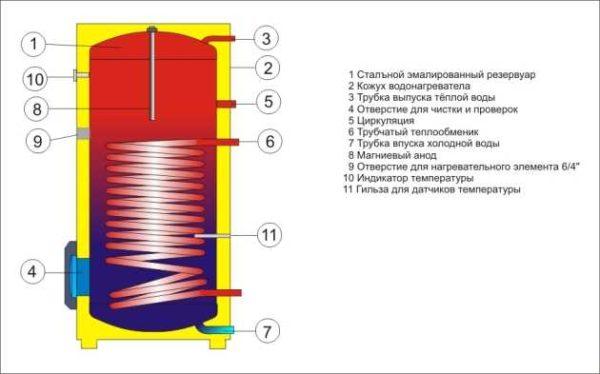
One of the important details in this design is a magnesium anode. It reduces the intensity of corrosion processes – the tank lasts longer.
Typer
There are two types of indirect heating boilers: with built-in control and without. Indirect boilers with built-in control are connected to the heating system, working from boilers without control. They have a built-in temperature sensor, their own control that turns on/off the supply of hot water to the coil. When connecting this type of equipment, all you need to do is connect the heating supply and return to the appropriate inputs, connect the cold water supply and connect the hot water distribution comb to the upper output. That’s it, you can fill the tank and start heating it.
Conventional indirect heating boilers work mainly with automated boilers. During installation it is necessary to install a temperature sensor in a certain place (there is a hole in the body) and connect it to a certain boiler input. Then do the piping of the indirect heating boiler in accordance with one of the schemes. You can also connect them to non-volatile boilers, but this requires special schemes (there are below).
What it should be remembered that the water in the indirect boiler can be heated just below the temperature of the coolant circulating in the coil. So if you have a boiler in a low-temperature mode and gives, say +40 ° C, the maximum temperature of water in the tank will be just so. You will not be able to heat it any more. To get around this limitation, there are combined water heaters. They have a coil and a built-in heating element. The main heating in this case comes at the expense of the coil (indirect heating), and the heater only brings the temperature to the set temperature. Also, such systems are good when paired with solid fuel boilers – the water will be warm even when the fuel has burned through.
What else can be said about the features of the design? In large volume indirect heaters install several heat exchangers – this reduces the time of water heating. To reduce the time of water heating and for slower cooling of the tank, it is better to choose models with thermal insulation.
Which boilers can be connected to
Boilers of indirect heating can work with any source of hot water. Any hot water boiler – solid fuel boiler – on wood, coal, briquettes, pellets – will do. You can connect to any type of gas boiler, electric or working on liquid fuel.
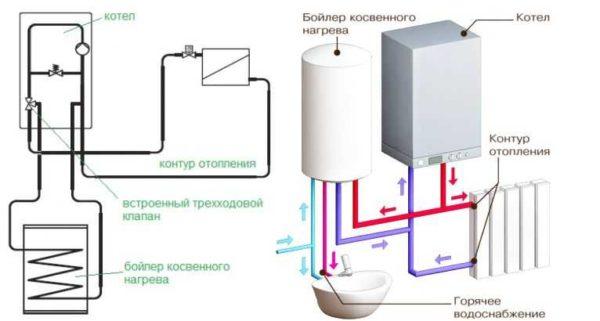
Just, as already written above, there are models with their own control, and then their installation and strapping – a simpler task. If the model is simple, you have to think about the system of temperature regulation and switching the boiler from heating radiators, to heating hot water.
Tank shapes and installation methods
Boiler indirect heating can be installed on the floor, can – hung on the wall. Wall-mounted versions have a capacity of no more than 200 liters, and floor-mounted can hold up to 1500 liters. In both cases there are horizontal and vertical models. When installing a wall-mounted variant, the fastening is standard – brackets, which are mounted on dowels of the appropriate type.
If we talk about the shape, then most often these devices are made in the form of a cylinder. Almost in all models, all the working outputs (connection pipes) are brought out from the back. So it is easier to connect, and the appearance is better. On the front of the panel there are places for installing a temperature sensor or thermorelay, in some models there is an option to install a TEN – for additional heating of water when there is a lack of heating power.
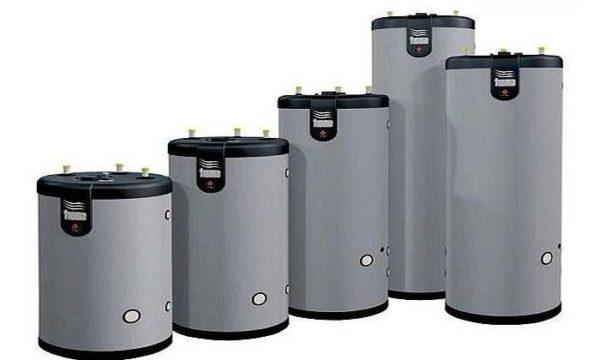
When installing the system, it is worth remembering that the system will work effectively only if the boiler power will be sufficient.
Schemes and peculiarities of connection
There are two principles of connection of the indirect heating boiler: with priority heating of hot water and without. When heating with priority, if necessary, the entire coolant is pumped through the heat exchanger of the boiler. Heating takes a short time. As soon as the temperature reaches the set temperature (controlled by a sensor, thermostatic valve or thermostatic relay), the entire flow is again directed to the radiators.
In schemes without water heating priority, only a certain part of the heating medium flow is directed to the indirect water heater. This causes the water to take a long time to warm up.
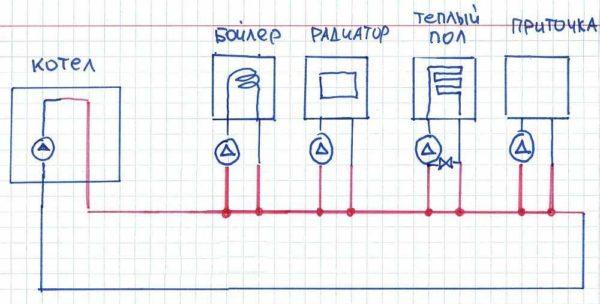
When connecting an indirect water heater, it is better to choose a scheme with priority – it provides hot water in the required amount. In this case, heating does not suffer much – for heating the entire volume of water is usually enough for 20-40 minutes, and to maintain the temperature at a flow rate of generally 3-8 minutes. During this time, no house can not cool down enough to be felt. But this is assuming that the boiler capacity is comparable to the boiler. Ideally – the boiler is more productive, with a reserve of 25-30%.
Allmänna regler
To ensure the normal operation of all appliances connected to the hot water comb, at the outlet of the boiler is installed expansion tank for hot water (not for heating). Its volume is 10% of the tank volume. It is necessary to neutralize thermal expansion.
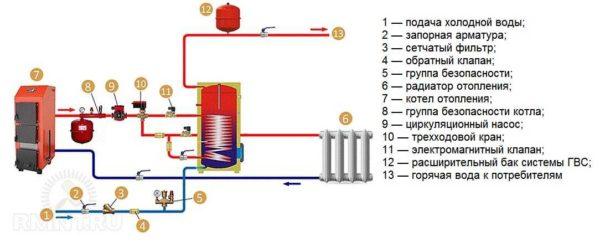
Also in each branch of the connection are installed cutoff valves (ball valves). They are necessary in order to be able to each device – three-way valve, circulation pump, etc. – can be disconnected and serviced if necessary.
Check valves are usually also installed on the supply pipes. These are necessary to eliminate the possibility of backflow. In this case, the connection of the indirect heating boiler will be safe and easy to maintain.
Installation next to the boiler in a system with forced circulation (with 3-way valve)
If there is already a circulation pump in the system, and it is installed on the supply, and the forced heating boiler can be placed next to the boiler, it is better to organize a separate circuit, which comes from the heating boiler. This connection of the indirect heating boiler is realized with most wall-mounted gas or other boilers, in which the circulation pump is on the supply pipe. With this connection scheme it turns out that the water heater and the heating system are connected in parallel.
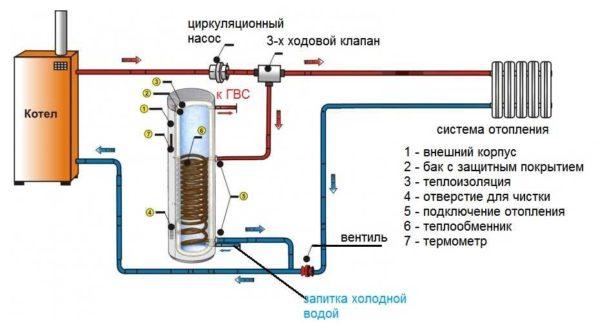
With this method of piping after the circulation pump is installed three-way valve, controlled by a temperature sensor (installed on the boiler). One of the outputs of the three-way valve is connected to the boiler socket for heating connection. In the return pipeline before the entrance to the boiler is cut into the tee, it is connected to the branch pipe for water removal from the heat exchanger. Actually, tapping into the heating system is finished.
The order of operation of this scheme is as follows:
- When receiving information from the sensor that the water temperature is below the set temperature, the three-way valve switches the coolant to the boiler. The heating system is switched off.
- All the coolant flow goes through the heat exchanger and the water in the tank is heated.
- The water is heated enough, the three-way valve redirects the coolant to the heating system.
As you can see, the scheme is simple, its operation is also clear.
Scheme with two circulation pumps
Pir installation of the water heater in the system in the circulation pump, but not next to it, but at some distance, it is better to install a circulation pump in the circuit on the water heater. Connection of the indirect boiler for this case is shown in the diagram below.
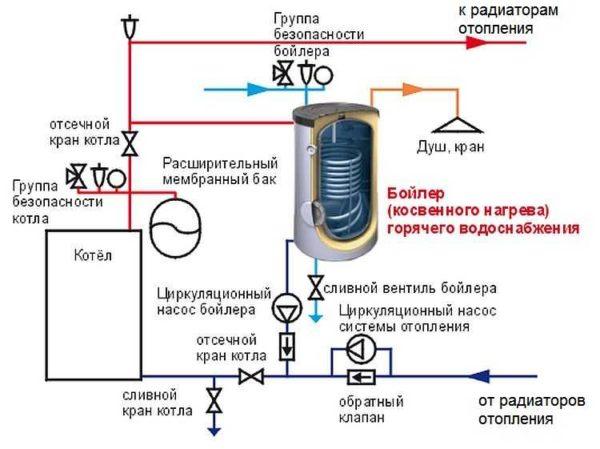
The circulation pump can be installed either on the supply pipe or on the return pipe. In this scheme there is no three-way valve, the circuit is connected through the usual tees. Switching the flow of coolant is carried out by switching on/off the pumps, and it is controlled by a temperature sensor, which has two pairs of contacts.
If the water in the tank is colder than the set value on the sensor, the circulating pump in the boiler circuit is energized. When the set degree of heating is reached, the contacts of the pump are closed, which drives the coolant into the heating system.
Scheme for non-volatile boiler
In the scheme with energy-independent boiler to ensure the priority of the boiler, it is desirable that it is located higher than the radiators. That is, in this case, the installation of wall-mounted models is desirable. Ideally, the bottom of the indirect water heater is above the boiler and radiators. But such an arrangement is not always possible.
Schemes will work and with the floor location of the boiler, but the water will be heated more slowly and in the bottom part it will not be hot enough. Its temperature will be comparable to the degree of heating of the return pipe, i.e. the hot water reserve will be smaller.
With non-volatile heating, the movement of the coolant is due to gravity. In principle, you can connect the indirect heating boiler according to the traditional scheme – with a circulation pump in the circuit for its heating. Just in this case, when the electricity is off, there will be no hot water. If you are not satisfied with such a turn, there are several schemes that will work with gravity systems.
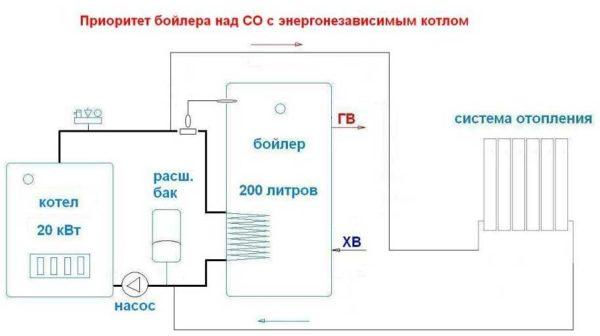
When implementing this scheme, the circuit that goes to the water heater is made by a pipe with a diameter 1 step larger than the heating pipe. This ensures the priority.
In this scheme, a thermostatic head with an overhead sensor is installed after the branch to the heating system. It works from batteries, it does not require external power supply. On the regulator of the thermostatic head the desired temperature of water heating is set (not higher than the boiler supply temperature). While the water in the tank is cold, the thermostat opens the supply to the boiler, the flow of coolant goes mainly to the boiler. When the water is heated to the required degree, the coolant is redirected to the heating branch.
With coolant recirculation
If there is a water towel dryer in the system, a constant circulation of water through it is necessary. Otherwise it will not work. In the recirculation loop, you can connect all consumers. In this case, hot water will be constantly chased in a circle by a pump. In this case, opening the water at any time you will get hot water at once – you will not have to wait for cold water to flow out of the pipes. This is a positive moment.
The negative is that by connecting recirculation, we increase the cost of heating water in the boiler. Why? Because running through the ring the water cools down, therefore the boiler will be connected more often to heat water and spend more fuel on it.
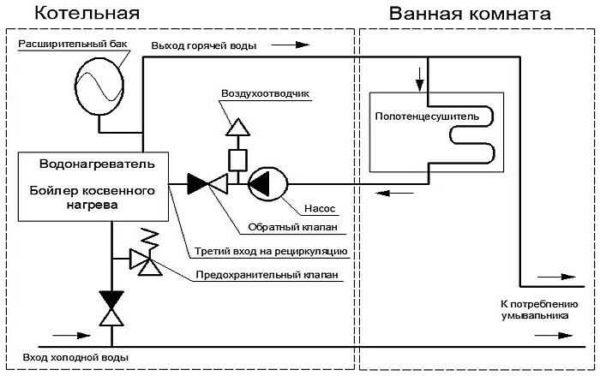
The second disadvantage is that recirculation stimulates mixing of water layers. In normal operation, the hottest water is at the top, from where it is fed into the DHW circuit. With mixing, the overall temperature of the water supplied drops (at the same settings). Nevertheless, for a towel radiator this is probably the only way out.
How to realize the connection of an indirect heating boiler with recirculation? There are several ways. The first is to find special indirect heaters with built-in recirculation. Very convenient – the towel dryer (or the entire loop) is simply connected to the appropriate spigots. But the price of such variants of water heaters is almost twice as much as the price of a conventional tank of the same volume.
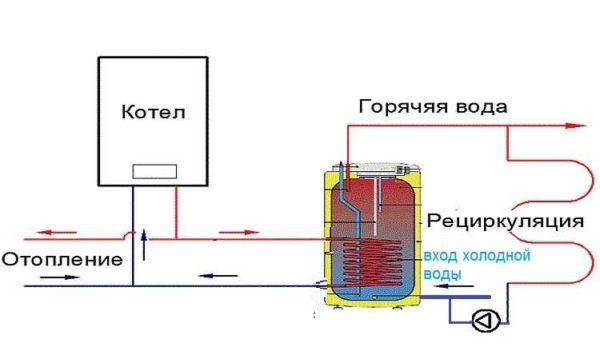
The second option is to use models that do not have an inlet for connecting the recirculation loop, but connect it with the help of tees.

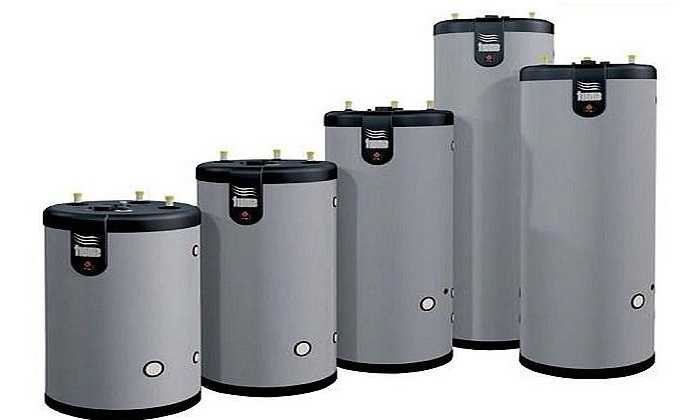
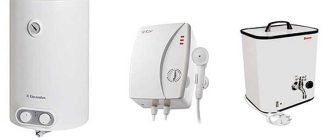


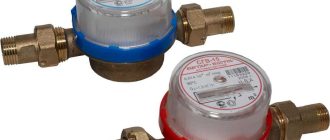
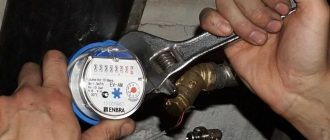
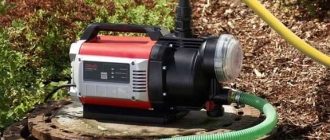
I remember when I tackled hooking up my indirect boiler for the first time. It felt like a puzzle! Having clear steps made it way easier. Super glad I didn’t rush, and now I enjoy cozy hot showers. Great guide for anyone looking to dive in!
Oh man, I feel you! I was totally lost trying to set up my heater last winter. Took my time, followed some step-by-step vids, and finally nailed it. Now, those hot showers are my guilty pleasure after a long day. Patience pays off for sure!
Totally get you! I had my heater struggle too last winter. Spent hours on YouTube, finally got it right, and those cozy evenings were worth it. Nothing beats stripping off the chill for a hot shower after battling the cold. Patience really is the name of the game!
Totally relate! Last winter, my heater gave up too. I was freezing and spent ages on YouTube figuring it out. Finally got it working just in time for some cozy nights. And yeah, nothing feels better than a hot shower after that chilly fight! Patience is key, for sure!